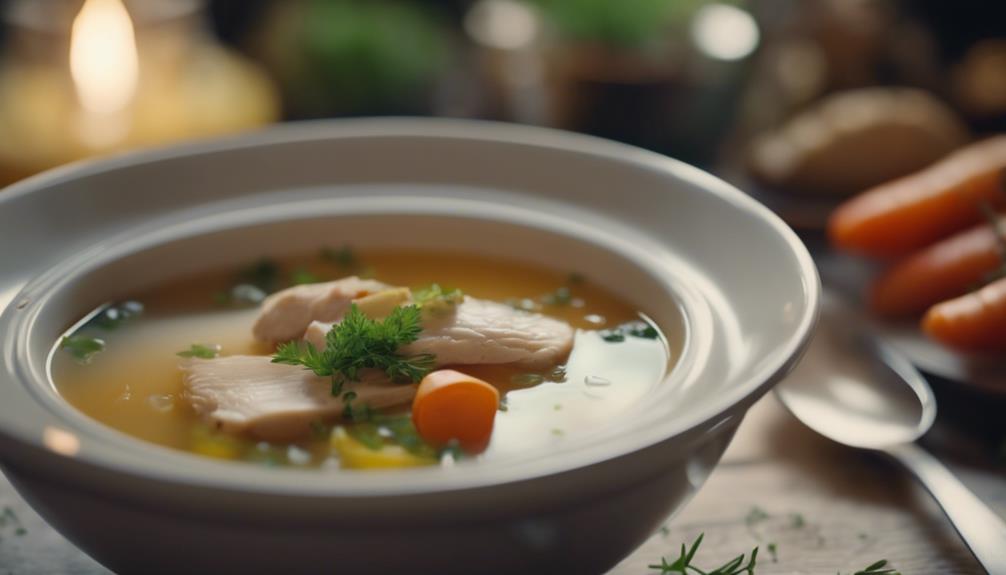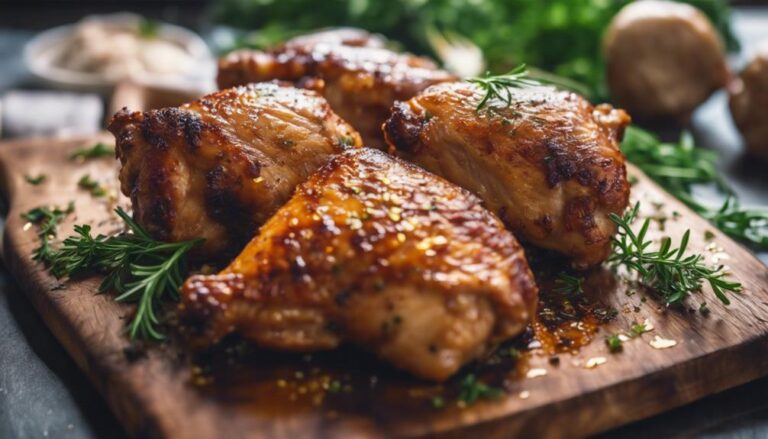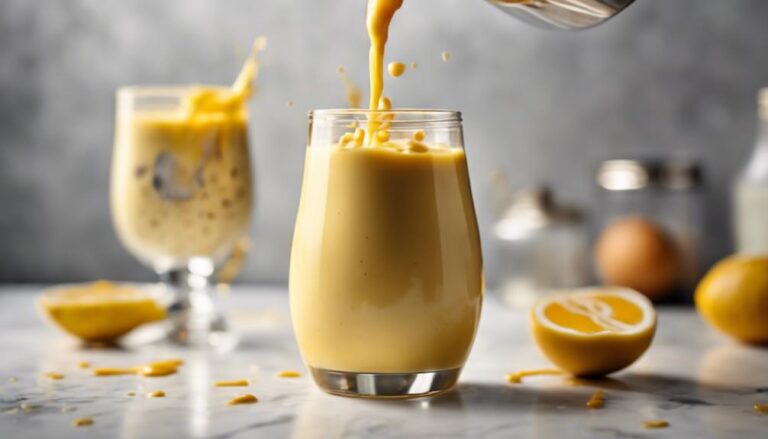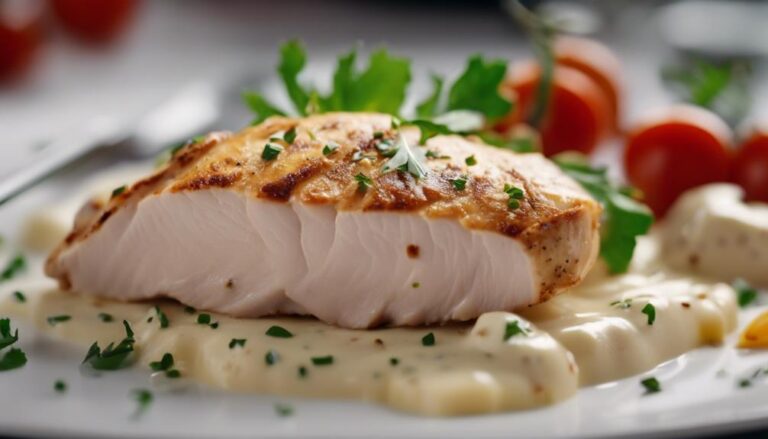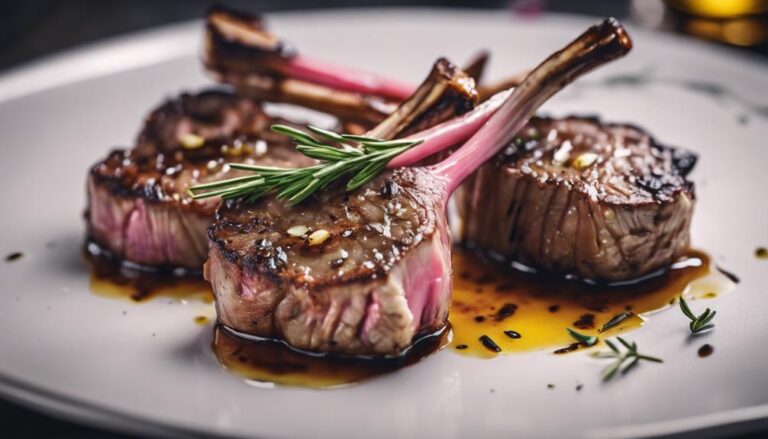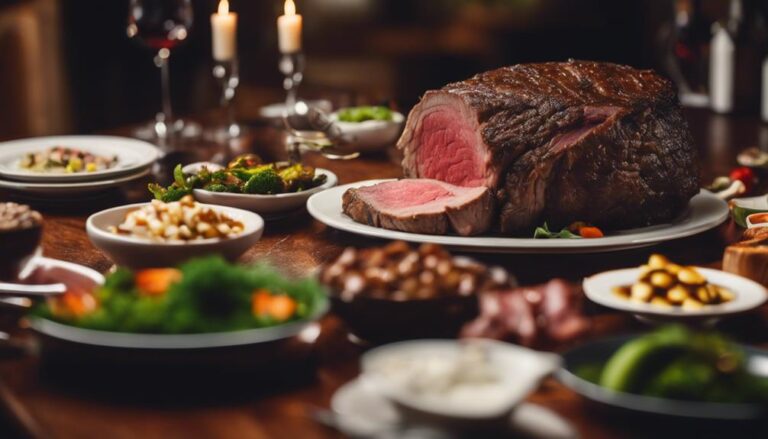Sous Vide Chicken Soup: Pure Protein Comfort
Indulge in sous vide chicken soup for a pure protein comfort. Sous vide cooking at 165°F for 2 to 4 hours melds flavors perfectly, creating a rich, aromatic broth. Equip yourself with a sous vide machine, vacuum sealer, and water bath for best results. Season to your taste, ensuring juicy, tender chicken. This precise cooking method elevates texture, taste, and overall satisfaction.
What You Will Learn Here
- Sous vide cooking ensures optimal flavor infusion and precise temperature control for a rich and aromatic chicken soup.
- Use essential sous vide equipment like a machine, vacuum sealer, and water bath for consistent and juicy results.
- Adjust seasonings to taste preferences and achieve perfect chicken texture with sous vide cooking.
- Enjoy pure protein comfort with sous vide chicken soup, enhancing quality, texture, and overall taste experience.
- Sous vide chicken soup cooked at 165°F (73.9°C) for 2 to 4 hours creates a flavorful and comforting dish.
Soup's Origin Story
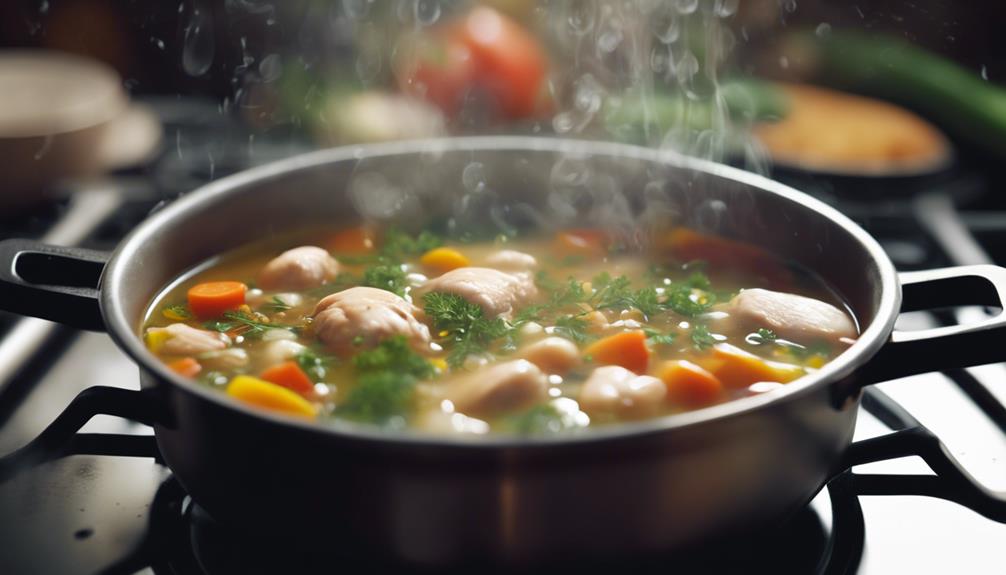
Explore the ancient roots of soup recipes, tracing the evolution of this culinary tradition through time.
Examine how soups have adapted and diversified across various cultures, forming unique and cherished culinary traditions.
Uncover the rich history behind the practice of soup-making, reflecting the cultural influences that have shaped this beloved dish.
Ancient Soup Recipes
Tracing back through history, discovering the roots of ancient soup recipes reveals a rich tapestry of culinary traditions and cultural practices. Ancient techniques such as simmering ingredients slowly over a fire or using natural seasonings like herbs and spices were foundational to creating flavorful soups.
These ancient recipes often incorporated a variety of ingredients like vegetables, meats, and grains, showcasing the diverse culinary skills of different cultures. Modern twists to these traditional methods have evolved with the introduction of new cooking technologies and ingredients, yet the essence of ancient soup recipes remains in the heart of many contemporary dishes.
Exploring the origins of soup not only provides insight into historical food practices but also offers a glimpse into the interconnectedness of global culinary heritage.
Evolution of Soups
Pioneering the culinary landscape, the evolution of soups traces back to ancient civilizations where innovative cooking methods and ingredient combinations laid the foundation for modern soup recipes.
Throughout history, soups have undergone evolutionary adaptations driven by culinary innovations. Ancient civilizations like the Greeks and Romans used soups as a way to utilize leftovers and create nourishing meals. Over time, as culinary techniques advanced, soups became more refined, with the incorporation of various herbs, spices, and proteins.
The evolution of soups continued with the development of diverse cooking methods such as boiling, simmering, and stewing, allowing for the creation of rich and complex flavors. These evolutionary adaptations in soup-making have paved the way for the diverse range of soups enjoyed today, showcasing the enduring legacy of culinary creativity.
Cultural Soup Traditions
The origins of soup can be traced back to ancient cultural traditions, where the art of combining ingredients to create flavorful broths and stews originated. Cultural influences play a significant role in shaping the diverse soup traditions seen today.
In various regions worldwide, traditional ingredients unique to each culture are used to craft distinctive soups that reflect their heritage. For example, Asian cultures often incorporate ingredients like miso, seaweed, and tofu, creating umami-rich broths. In contrast, Latin American soups may feature ingredients such as corn, beans, and chili peppers for a spicy and hearty flavor profile.
Understanding the cultural influences and traditional ingredients behind different soup variations adds depth and appreciation to the culinary experience of serving others.
Essential Soup Seasoning
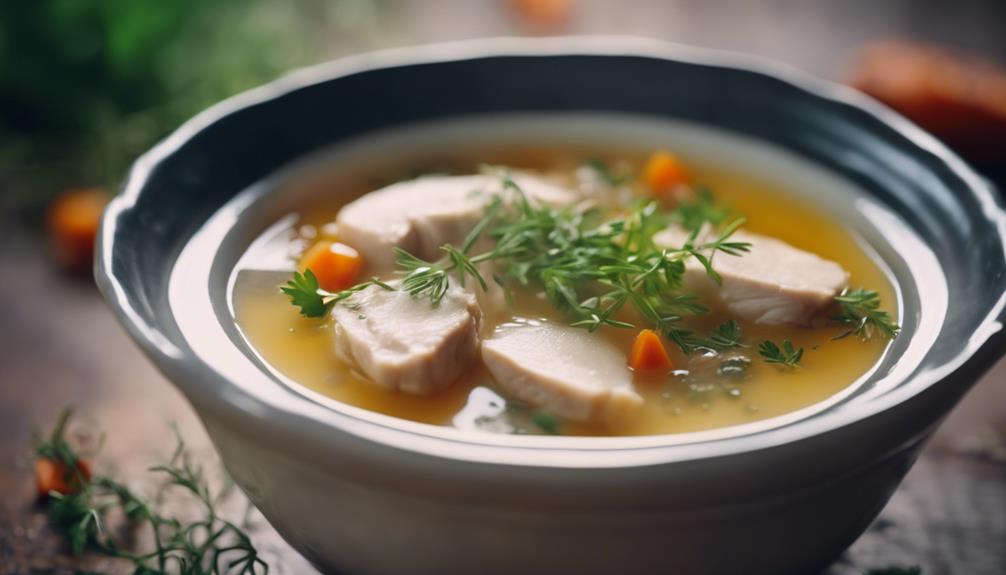
Consider incorporating a blend of traditional herbs and spices to enhance the flavor profile of your chicken soup. When seasoning your soup, follow these tips to create a harmonious and flavorful dish:
- Balanced Flavors: Achieve a well-rounded taste by combining herbs like thyme and rosemary with spices such as black pepper and bay leaves.
- Layering Flavors: Develop depth in your soup by adding ingredients at different stages of cooking, allowing the flavors to meld together.
- Umami Boost: Enhance the savory richness of your soup with ingredients like soy sauce, miso paste, or Parmesan cheese.
- Fresh Ingredients: Use fresh herbs and spices whenever possible to elevate the overall taste and aroma of your chicken soup.
- Customization: Experiment with different seasonings based on your preferences to create a unique and personalized soup experience.
Top-Rated Chicken Soup Recipes
When looking for top-rated chicken soup recipes, consider Sous Vide Chicken Noodle Soup, Savory Chicken and Vegetable Soup, and Hearty Chicken and Rice Soup.
These recipes offer a variety of flavors and textures, catering to different taste preferences.
Each recipe brings a unique twist to the classic chicken soup, making them popular choices among home cooks.
Sous Vide Chicken Noodle Soup
To guarantee a top-rated Sous Vide Chicken Noodle Soup, maintain precise temperature control during the cooking process. When creating this comforting dish, remember the importance of the following:
- Chicken Broth: Choose a high-quality chicken broth to enhance the depth of flavor in your soup.
- Noodle Variations: Experiment with different noodle types such as egg noodles, rice noodles, or even spiralized vegetables for a unique twist.
- Seasoning: Utilize a blend of herbs and spices to elevate the taste profile of your soup.
- Vegetable Additions: Incorporate a variety of vegetables like carrots, celery, and onions for added nutrients and texture.
- Toppings: Consider topping your soup with fresh herbs, a drizzle of olive oil, or a sprinkle of Parmesan cheese for a finishing touch.
Savory Chicken and Vegetable Soup
For best results, maintain precision in temperature control when preparing the Savory Chicken and Vegetable Soup, a highly-rated recipe among chicken soups. This dish offers a flavorful broth, protein-packed for a satisfying meal. Slow cooked to perfection, it blends comforting flavors that will surely warm your soul.
To make this soup a standout dish, focus on these key steps:
- Use fresh vegetables for the best taste.
- Season the broth generously with herbs and spices.
- Simmer the soup slowly to allow flavors to meld perfectly.
- Add shredded chicken for an extra protein boost.
- Serve hot with a side of crusty bread for a complete meal experience.
Hearty Chicken and Rice Soup
In crafting the Hearty Chicken and Rice Soup, prioritize the precise measurement of ingredients to achieve a balanced flavor profile. Slow cooking this comfort food guarantees the flavors meld beautifully, offering a warm and satisfying dish to those you serve.
Follow these steps for a delightful outcome:
- Choose High-Quality Chicken: Opt for boneless, skinless chicken thighs for richer flavor.
- Use Arborio Rice: Its creamy texture enhances the soup's consistency.
- Add Fresh Herbs: Rosemary and thyme bring a fragrant depth to the broth.
- Simmer Slowly: Let the soup simmer gently to allow the flavors to intensify.
- Adjust Seasoning: Taste and adjust seasoning towards the end for a perfectly balanced taste.
Sous Vide Timing Secrets
To achieve ideal flavor in your sous vide chicken soup, it's essential to adhere to precise cooking temperatures and timings. Understanding the timing secrets will guarantee that your soup is perfectly cooked and bursting with flavor.
Make sure you have the necessary sous vide equipment to execute the recipe flawlessly.
Precise Cooking Temperatures
Achieve peak results by adhering strictly to the recommended cooking temperatures when preparing sous vide dishes. Cooking techniques and temperature control are essential in sous vide cooking to guarantee precise outcomes.
Maintaining a consistent temperature throughout the cooking process allows for flavor infusion and texture perfection. By setting your sous vide machine to the specified temperature for the desired doneness of your chicken soup, you can achieve unparalleled results.
The controlled environment of sous vide cooking guarantees that your ingredients are cooked evenly and retain their natural flavors. Paying meticulous attention to the precise cooking temperatures will elevate the quality of your chicken soup, providing a comforting and delicious meal for those you serve.
Timing for Optimal Flavor
Timing plays a pivotal role in revealing the best flavors in sous vide cooking, exposing secret nuances that enhance the overall taste experience. Achieving ideal flavor infusion in your sous vide chicken soup requires precise timing. For chicken soup, a cooking time of 2 to 4 hours at 165°F (73.9°C) is perfect. This duration allows the flavors from the herbs, vegetables, and chicken to meld perfectly, creating a rich and aromatic broth.
Additionally, timing is essential for texture perfection. Cooking the chicken for too long can result in a mushy texture, while undercooking may leave the meat tough. By following the recommended timing guidelines, you guarantee that your sous vide chicken soup is bursting with flavor and has a tender, succulent texture that will delight your guests.
Sous Vide Equipment Needed
For best performance of sous vide cooking, make sure you have the necessary equipment, which is essential for achieving precise results and realizing the full potential of your culinary creations. Sous vide benefits from using a sous vide machine, vacuum sealer, and water bath container.
The sous vide machine controls the water temperature with accuracy, ensuring your ingredients cook evenly. A vacuum sealer removes air from the bags, allowing for better heat transfer and preventing water from seeping in. The water bath container maintains a consistent temperature throughout the cooking process.
When using sous vide cooking techniques, tips like ensuring proper sealing of ingredients in bags and preheating the water bath can further enhance your dishes. Investing in quality sous vide equipment will elevate your cooking experience and results.
Final Thoughts
To recap, consider adjusting the seasoning to suit your personal taste preferences for the perfect finishing touch to your sous vide chicken soup. Reflections on the process reveal that sous vide cooking guarantees that your chicken is cooked to perfection, tender, and retains maximum flavor.
The advantages of using this cooking method include precise temperature control, resulting in a consistent and juicy outcome every time. This contributes to the comfort and satisfaction experienced when enjoying a bowl of warm, hearty chicken soup.
When preparing your sous vide chicken soup, remember that the final seasoning step is essential for enhancing the overall taste. Take a moment to taste the broth before serving and make any necessary adjustments to salt, pepper, or herbs to achieve the ideal flavor profile.
Frequently Asked Questions
Can I Use Bone-In Chicken for Sous Vide Chicken Soup?
Yes, you can use bone-in chicken for sous vide chicken soup. However, boneless alternatives might be easier to handle. Adjust cooking times accordingly, as bone-in chicken may require longer to reach the desired level of tenderness compared to boneless cuts.
How Can I Add a Smoky Flavor to the Soup?
To add a smoky infusion to your soup, consider using flavor enhancers like smoked paprika, liquid smoke, or charred vegetables. These elements will elevate your dish, providing a rich and complex taste profile.
Is It Safe to Leave the Sous Vide Machine Unattended?
Leaving the sous vide machine unattended poses potential risks. Always follow safety precautions, such as ensuring proper water levels and monitoring for any malfunctions. While convenience is a benefit, being vigilant is essential for safe cooking.
Can I Freeze Sous Vide Chicken Soup for Later?
Yes, you can freeze sous vide chicken soup for later. Employ proper freezing techniques by cooling the soup rapidly before transferring it to a freezer-safe container. Guarantee airtight sealing to prevent freezer burn. This method allows for long term storage without compromising taste or quality.
What Other Meats Can I Use for Sous Vide Soup Besides Chicken?
When making sous vide soup, consider using beef broth for a rich flavor and tender meat. Pork loin also works well due to its lean yet succulent characteristics. Experiment with different meats to find your perfect sous vide soup combination.
Conclusion
To sum up, sous vide chicken soup offers a pure protein comfort that's both flavorful and nutritious.
By using precise timing techniques and top-rated recipes, you can create a delicious and satisfying soup that's sure to warm your soul.
Remember to season your soup with essential ingredients to enhance the flavors and elevate your dining experience.
Enjoy the benefits of sous vide cooking and indulge in a bowl of comforting chicken soup today.
